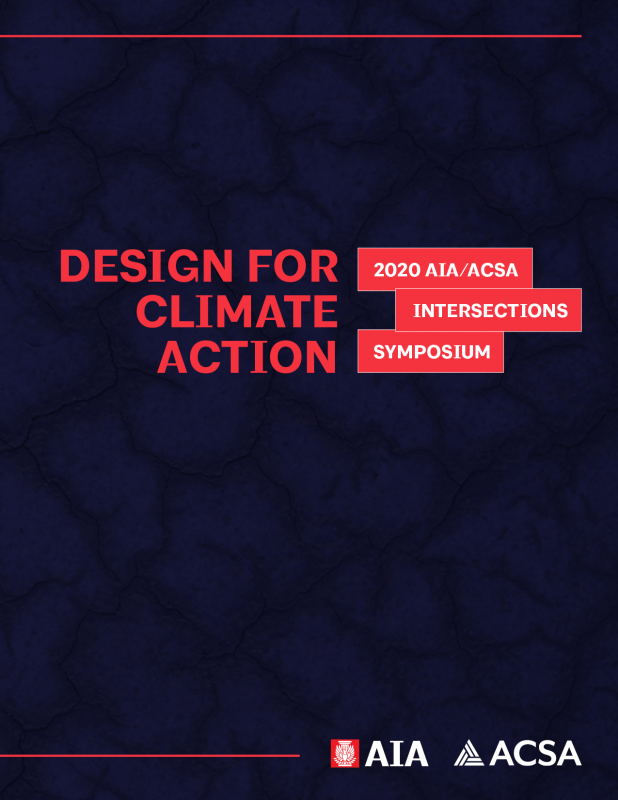Design for Climate Action
Symposium Description
The American Institute of Architects (AIA) and the Association of Collegiate Schools of Architecture (ACSA) are pleased to partners for symposium dedicated to the INTERSECTION of Education, Research and Practice.
Take Action to address climate and the built environment & earn HSW credit! Join us for Design for Climate Action: Intersections Symposium – two 90-minute educational sessions, 4:00-5:30 pm, July 28 and 29 – designed to share important research which Intersects Practice and Academia and can lead to new ways of addressing the critical issues of climate change.
Selected from a competitive submission of more than 120 projects that were blind, peer-reviewed, eight final projects have been curated by our Co-Chairs, Phoebe Crisman, and Kyle Konis, into two dynamic, 90 minute sessions, featuring important findings, in brief presentations, followed by a live, moderated discussion and audience Q&A.
Symposium Sessions
Achieving Climate Action through Practice, Academia, & Policy
July 28, 2020 4:00-5:30pm (EDT)
Moderators:
Phoebe Crisman, University of Virginia
Kyle Konis, University of Southern California
Panelists:
Ashlie Latiolais, University of Louisiana, Lafayette
Richard Mohler, University of Washington
Sasha Plotnikova, Cal Poly, Pomona
Ann Yoachim, Tulane University
Climate Action calls for design innovation, research, education, and community-based visions of equitable development, that is also climate-responsive design.
Join us and see how Collaboration and Reenvisioning across practice, academia, community, and government can be part of the answer. Ashlie Latiolais, AIA, shares her work in New Iberia, LA. She suggests new modes and methods of architectural practice and education to inspire a new generation of architects to re-imagine conventional deliverables in architectural community work. Richard Mohler, AIA, shares climate and social equity challenges created by single-family zoning. He shares the results from a collaboration of his University of Washington design studio, AIA Seattle, and city government to revise public policy to be more aligned with the city’s climate and social equity goals. Designer Sasha Plotnikova, illustrates how designing for de-growth presents an alternative model to conventional US urban development practices. She gives architects a way to help foster and realize community-based visions of equitable development that is also climate-responsive design. Ann Yoachim shares the work of Tulane’s community design center as a case study. Increased intensity of weather events and failing infrastructure result in regular flooding of streets, homes, and businesses (including the center itself). Responding to immediate needs and planning for potential climate futures is often in conflict. Engaged design process and scaffolded projects and research as climate action offer architecture practice and pedagogy an opportunity to respond. Join us for a lively discussion developing effective changes in education, practice and policy to realize climate action.
Designing Across Scales for Climate Action
July 29, 2020 4:00-5:30pm (EDT)
Moderators:
Phoebe Crisman, University of Virginia
Kyle Konis, University of Southern California
Panelists:
Stephanie Davidson, Ryerson University, Canada
Ariane Harrison, Pratt Institute
Zaneta Hong, University of Virginia
Jeffrey Huber, Florida Atlantic University
Impact the built environment across a range of scales, from innovative materials and technology to habitats, buildings, and infrastructure. Get inspired by the work of architects, students, clients, and community, as they address these issues and share new discoveries that can embolden and energize your practice.
Design for climate action can be pursued across a range of scales as these projects demonstrate. Learn about projects that tackle material exploration, buildings, habitats, systems, landscapes and infrastructure. The Pulp studio, from Stephanie Davidson, uses recycled cellulose-based materials to cast temporary, biodegradable, thin-shell monocoque structures. She asks designers to see materials as responsive, constantly transforming, and to take responsibility for where materials come from and where they end up. The Pollinators Pavilion by architect Ariane Harrison, seeks a larger role for architecture in environmental activism and focuses on biodiversity conservation and materials exploration. She uses artificial intelligence and automated scientific monitoring strategies to create and analyze habitat systems and increase building awareness. Salty Urbanism presented by Jeffrey Huber, AIA, features projects in Ft. Lauderdale, Florida and Venice, California. These projects use coastal-hazard adaptation design approach and urban place-building framework to protect economic, engineering, environmental, and quality of life issues, from potential impacts of sea-level rise, storm surge, rainfall and runoff within coastal zones. Landscape architect Zaneta Hong’s studio research demonstrates how our food systems and changes in agricultural practices could address growing global populations and impact climate change, while defining the role of architects and designers in transforming future landscapes and material systems.
Eric W. Ellis, ACSA
Director of Operations and Programs
202-785-2324
eellis@acsa-arch.org
Nissa Dahlin-Brown, EdD, Assoc. AIA
AIA, Director of Academic Engagement
nissadahlinbrown@aia.org
202.626.7449

 Study Architecture
Study Architecture  ProPEL
ProPEL 


